Siyuan Ma
Crowdsourcing-Based Knowledge Graph Construction for Drug Side Effects Using Large Language Models with an Application on Semaglutide
Apr 08, 2025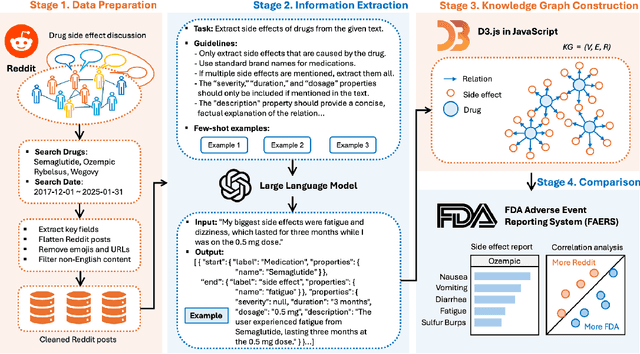
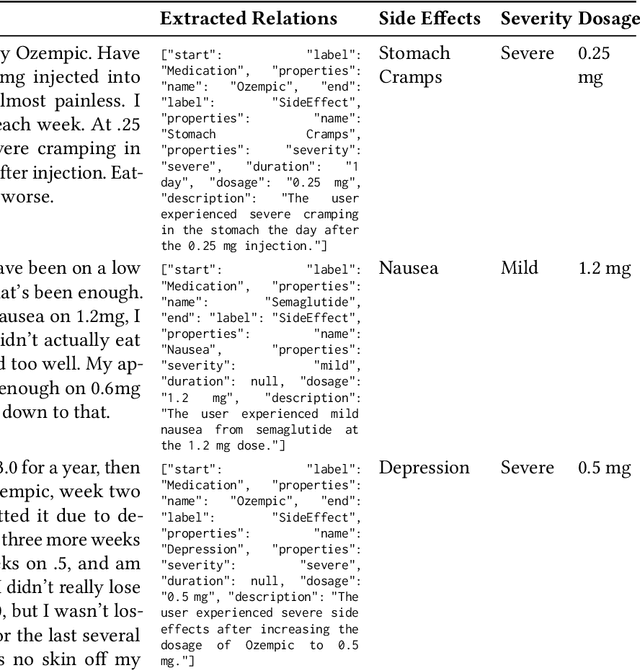
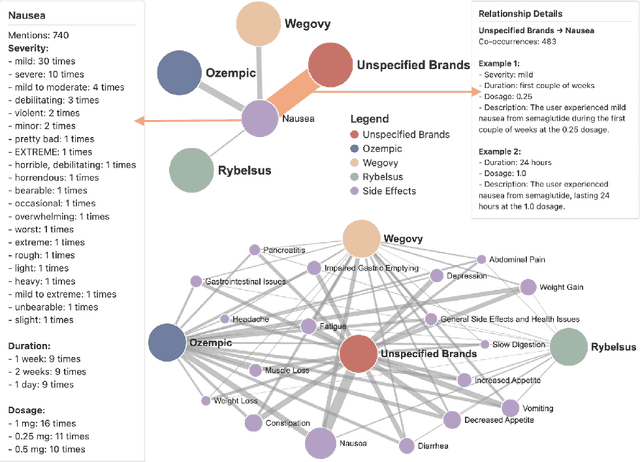
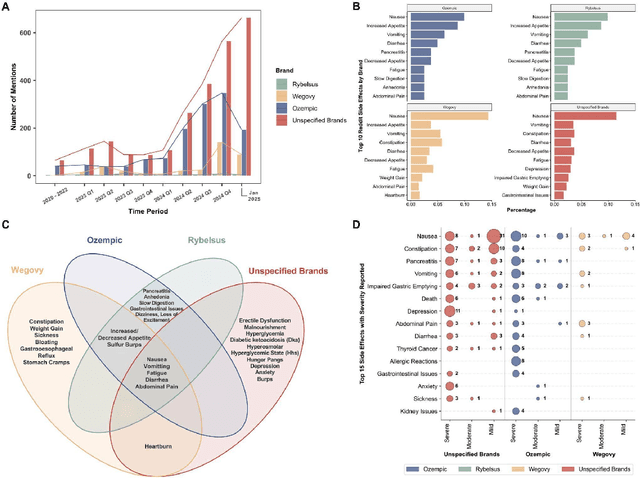
Abstract:Social media is a rich source of real-world data that captures valuable patient experience information for pharmacovigilance. However, mining data from unstructured and noisy social media content remains a challenging task. We present a systematic framework that leverages large language models (LLMs) to extract medication side effects from social media and organize them into a knowledge graph (KG). We apply this framework to semaglutide for weight loss using data from Reddit. Using the constructed knowledge graph, we perform comprehensive analyses to investigate reported side effects across different semaglutide brands over time. These findings are further validated through comparison with adverse events reported in the FAERS database, providing important patient-centered insights into semaglutide's side effects that complement its safety profile and current knowledge base of semaglutide for both healthcare professionals and patients. Our work demonstrates the feasibility of using LLMs to transform social media data into structured KGs for pharmacovigilance.
Patients Speak, AI Listens: LLM-based Analysis of Online Reviews Uncovers Key Drivers for Urgent Care Satisfaction
Mar 26, 2025Abstract:Investigating the public experience of urgent care facilities is essential for promoting community healthcare development. Traditional survey methods often fall short due to limited scope, time, and spatial coverage. Crowdsourcing through online reviews or social media offers a valuable approach to gaining such insights. With recent advancements in large language models (LLMs), extracting nuanced perceptions from reviews has become feasible. This study collects Google Maps reviews across the DMV and Florida areas and conducts prompt engineering with the GPT model to analyze the aspect-based sentiment of urgent care. We first analyze the geospatial patterns of various aspects, including interpersonal factors, operational efficiency, technical quality, finances, and facilities. Next, we determine Census Block Group(CBG)-level characteristics underpinning differences in public perception, including population density, median income, GINI Index, rent-to-income ratio, household below poverty rate, no insurance rate, and unemployment rate. Our results show that interpersonal factors and operational efficiency emerge as the strongest determinants of patient satisfaction in urgent care, while technical quality, finances, and facilities show no significant independent effects when adjusted for in multivariate models. Among socioeconomic and demographic factors, only population density demonstrates a significant but modest association with patient ratings, while the remaining factors exhibit no significant correlations. Overall, this study highlights the potential of crowdsourcing to uncover the key factors that matter to residents and provide valuable insights for stakeholders to improve public satisfaction with urgent care.
Fast training of large kernel models with delayed projections
Nov 25, 2024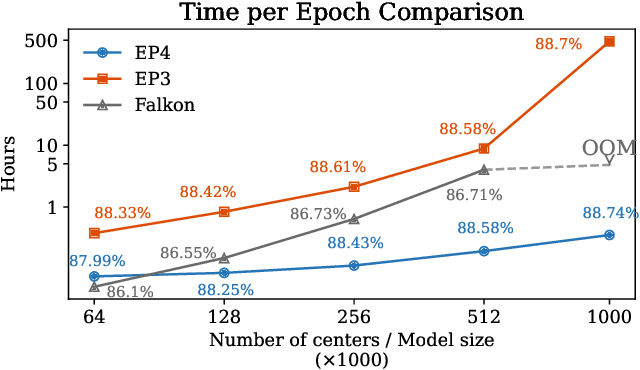



Abstract:Classical kernel machines have historically faced significant challenges in scaling to large datasets and model sizes--a key ingredient that has driven the success of neural networks. In this paper, we present a new methodology for building kernel machines that can scale efficiently with both data size and model size. Our algorithm introduces delayed projections to Preconditioned Stochastic Gradient Descent (PSGD) allowing the training of much larger models than was previously feasible, pushing the practical limits of kernel-based learning. We validate our algorithm, EigenPro4, across multiple datasets, demonstrating drastic training speed up over the existing methods while maintaining comparable or better classification accuracy.
Benchmarking Vision Language Model Unlearning via Fictitious Facial Identity Dataset
Nov 05, 2024



Abstract:Machine unlearning has emerged as an effective strategy for forgetting specific information in the training data. However, with the increasing integration of visual data, privacy concerns in Vision Language Models (VLMs) remain underexplored. To address this, we introduce Facial Identity Unlearning Benchmark (FIUBench), a novel VLM unlearning benchmark designed to robustly evaluate the effectiveness of unlearning algorithms under the Right to be Forgotten setting. Specifically, we formulate the VLM unlearning task via constructing the Fictitious Facial Identity VQA dataset and apply a two-stage evaluation pipeline that is designed to precisely control the sources of information and their exposure levels. In terms of evaluation, since VLM supports various forms of ways to ask questions with the same semantic meaning, we also provide robust evaluation metrics including membership inference attacks and carefully designed adversarial privacy attacks to evaluate the performance of algorithms. Through the evaluation of four baseline VLM unlearning algorithms within FIUBench, we find that all methods remain limited in their unlearning performance, with significant trade-offs between model utility and forget quality. Furthermore, our findings also highlight the importance of privacy attacks for robust evaluations. We hope FIUBench will drive progress in developing more effective VLM unlearning algorithms.
Recent advances in deep learning and language models for studying the microbiome
Sep 15, 2024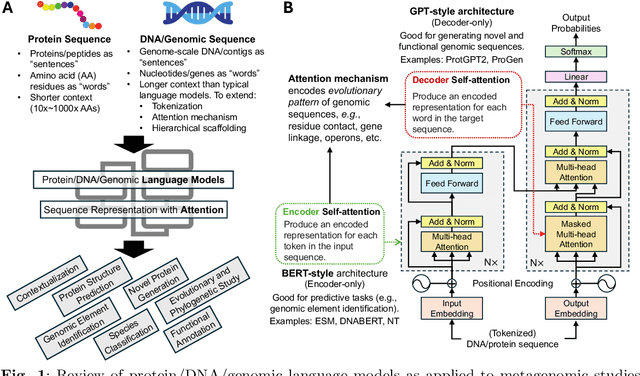

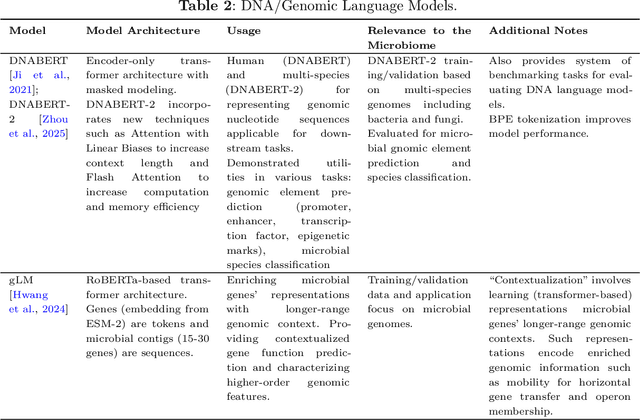

Abstract:Recent advancements in deep learning, particularly large language models (LLMs), made a significant impact on how researchers study microbiome and metagenomics data. Microbial protein and genomic sequences, like natural languages, form a language of life, enabling the adoption of LLMs to extract useful insights from complex microbial ecologies. In this paper, we review applications of deep learning and language models in analyzing microbiome and metagenomics data. We focus on problem formulations, necessary datasets, and the integration of language modeling techniques. We provide an extensive overview of protein/genomic language modeling and their contributions to microbiome studies. We also discuss applications such as novel viromics language modeling, biosynthetic gene cluster prediction, and knowledge integration for metagenomics studies.
Visual-RolePlay: Universal Jailbreak Attack on MultiModal Large Language Models via Role-playing Image Characte
May 25, 2024Abstract:With the advent and widespread deployment of Multimodal Large Language Models (MLLMs), ensuring their safety has become increasingly critical. To achieve this objective, it requires us to proactively discover the vulnerability of MLLMs by exploring the attack methods. Thus, structure-based jailbreak attacks, where harmful semantic content is embedded within images, have been proposed to mislead the models. However, previous structure-based jailbreak methods mainly focus on transforming the format of malicious queries, such as converting harmful content into images through typography, which lacks sufficient jailbreak effectiveness and generalizability. To address these limitations, we first introduce the concept of "Role-play" into MLLM jailbreak attacks and propose a novel and effective method called Visual Role-play (VRP). Specifically, VRP leverages Large Language Models to generate detailed descriptions of high-risk characters and create corresponding images based on the descriptions. When paired with benign role-play instruction texts, these high-risk character images effectively mislead MLLMs into generating malicious responses by enacting characters with negative attributes. We further extend our VRP method into a universal setup to demonstrate its generalizability. Extensive experiments on popular benchmarks show that VRP outperforms the strongest baseline, Query relevant and FigStep, by an average Attack Success Rate (ASR) margin of 14.3% across all models.
JailBreakV-28K: A Benchmark for Assessing the Robustness of MultiModal Large Language Models against Jailbreak Attacks
Apr 03, 2024Abstract:With the rapid advancements in Multimodal Large Language Models (MLLMs), securing these models against malicious inputs while aligning them with human values has emerged as a critical challenge. In this paper, we investigate an important and unexplored question of whether techniques that successfully jailbreak Large Language Models (LLMs) can be equally effective in jailbreaking MLLMs. To explore this issue, we introduce JailBreakV-28K, a pioneering benchmark designed to assess the transferability of LLM jailbreak techniques to MLLMs, thereby evaluating the robustness of MLLMs against diverse jailbreak attacks. Utilizing a dataset of 2, 000 malicious queries that is also proposed in this paper, we generate 20, 000 text-based jailbreak prompts using advanced jailbreak attacks on LLMs, alongside 8, 000 image-based jailbreak inputs from recent MLLMs jailbreak attacks, our comprehensive dataset includes 28, 000 test cases across a spectrum of adversarial scenarios. Our evaluation of 10 open-source MLLMs reveals a notably high Attack Success Rate (ASR) for attacks transferred from LLMs, highlighting a critical vulnerability in MLLMs that stems from their text-processing capabilities. Our findings underscore the urgent need for future research to address alignment vulnerabilities in MLLMs from both textual and visual inputs.
Understanding News Creation Intents: Frame, Dataset, and Method
Dec 27, 2023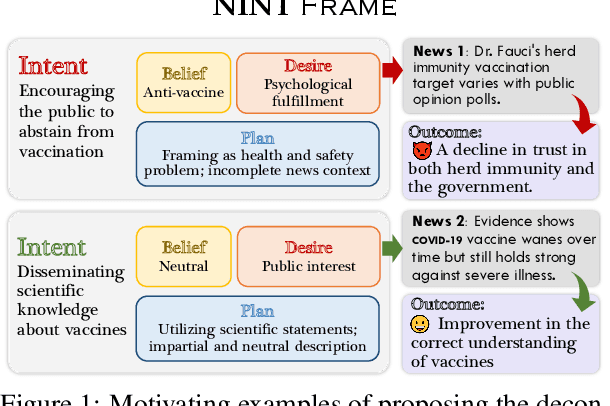
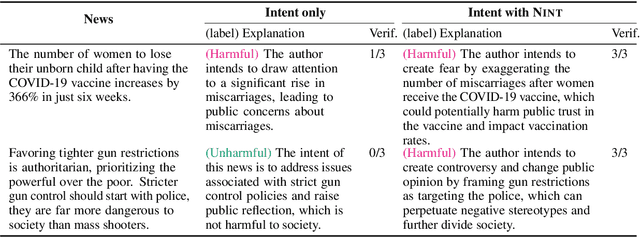
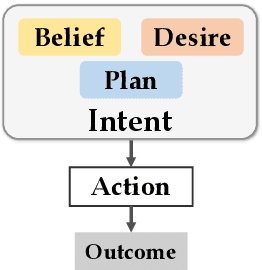
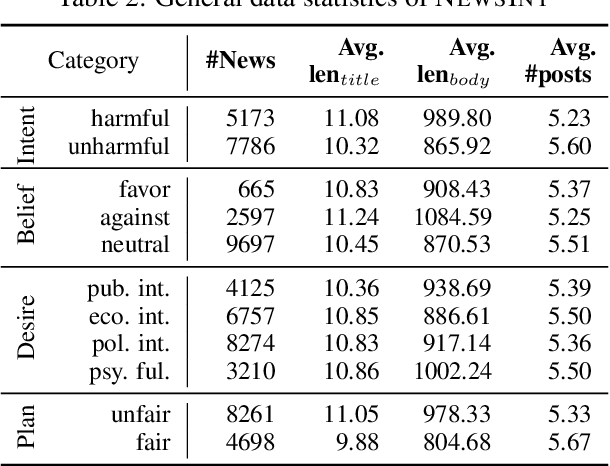
Abstract:As the disruptive changes in the media economy and the proliferation of alternative news media outlets, news intent has progressively deviated from ethical standards that serve the public interest. News intent refers to the purpose or intention behind the creation of a news article. While the significance of research on news intent has been widely acknowledged, the absence of a systematic news intent understanding framework hinders further exploration of news intent and its downstream applications. To bridge this gap, we propose News INTent (NINT) frame, the first component-aware formalism for understanding the news creation intent based on research in philosophy, psychology, and cognitive science. Within this frame, we define the news intent identification task and provide a benchmark dataset with fine-grained labels along with an efficient benchmark method. Experiments demonstrate that NINT is beneficial in both the intent identification task and downstream tasks that demand a profound understanding of news. This work marks a foundational step towards a more systematic exploration of news creation intents.
Summary of ChatGPT/GPT-4 Research and Perspective Towards the Future of Large Language Models
Apr 08, 2023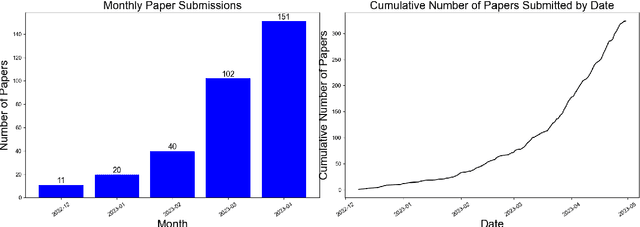


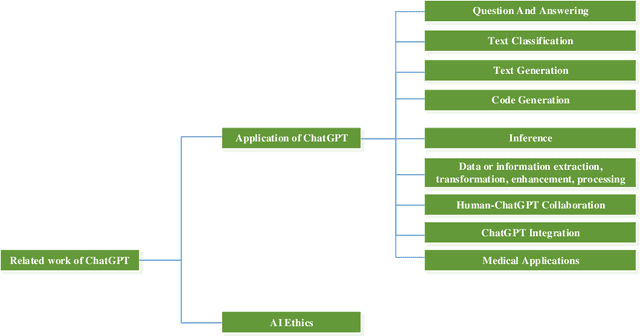
Abstract:This paper presents a comprehensive survey of ChatGPT and GPT-4, state-of-the-art large language models (LLM) from the GPT series, and their prospective applications across diverse domains. Indeed, key innovations such as large-scale pre-training that captures knowledge across the entire world wide web, instruction fine-tuning and Reinforcement Learning from Human Feedback (RLHF) have played significant roles in enhancing LLMs' adaptability and performance. We performed an in-depth analysis of 194 relevant papers on arXiv, encompassing trend analysis, word cloud representation, and distribution analysis across various application domains. The findings reveal a significant and increasing interest in ChatGPT/GPT-4 research, predominantly centered on direct natural language processing applications, while also demonstrating considerable potential in areas ranging from education and history to mathematics, medicine, and physics. This study endeavors to furnish insights into ChatGPT's capabilities, potential implications, ethical concerns, and offer direction for future advancements in this field.
Learning the joint distribution of two sequences using little or no paired data
Dec 06, 2022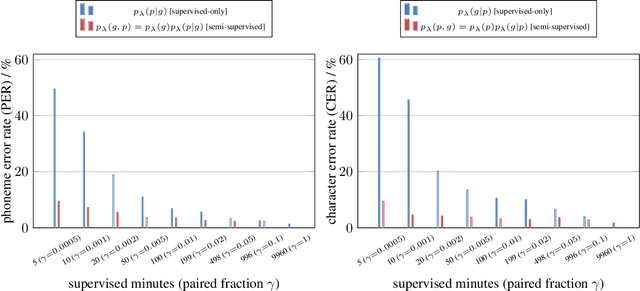



Abstract:We present a noisy channel generative model of two sequences, for example text and speech, which enables uncovering the association between the two modalities when limited paired data is available. To address the intractability of the exact model under a realistic data setup, we propose a variational inference approximation. To train this variational model with categorical data, we propose a KL encoder loss approach which has connections to the wake-sleep algorithm. Identifying the joint or conditional distributions by only observing unpaired samples from the marginals is only possible under certain conditions in the data distribution and we discuss under what type of conditional independence assumptions that might be achieved, which guides the architecture designs. Experimental results show that even tiny amount of paired data (5 minutes) is sufficient to learn to relate the two modalities (graphemes and phonemes here) when a massive amount of unpaired data is available, paving the path to adopting this principled approach for all seq2seq models in low data resource regimes.
 Add to Chrome
Add to Chrome Add to Firefox
Add to Firefox Add to Edge
Add to Edge